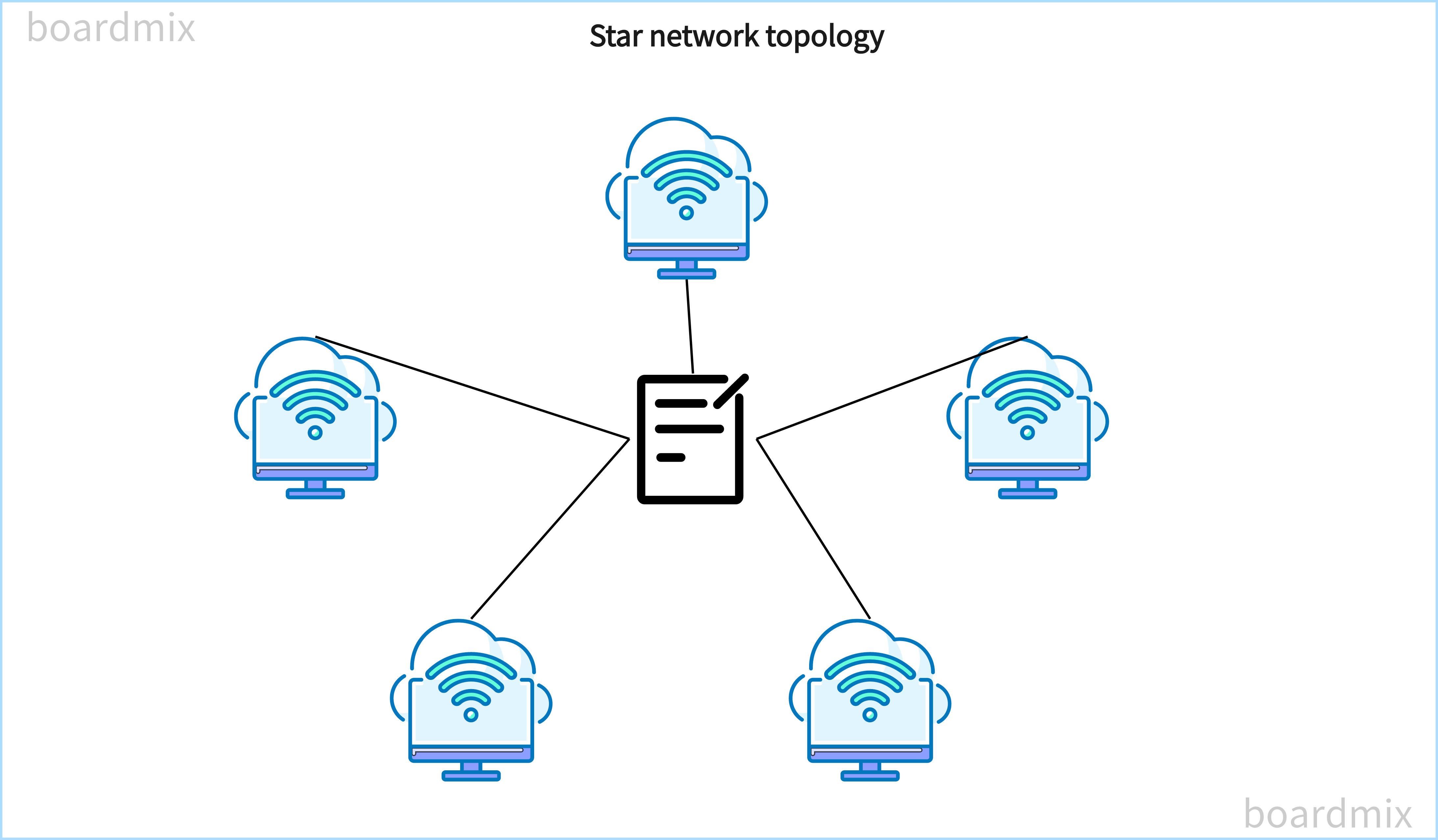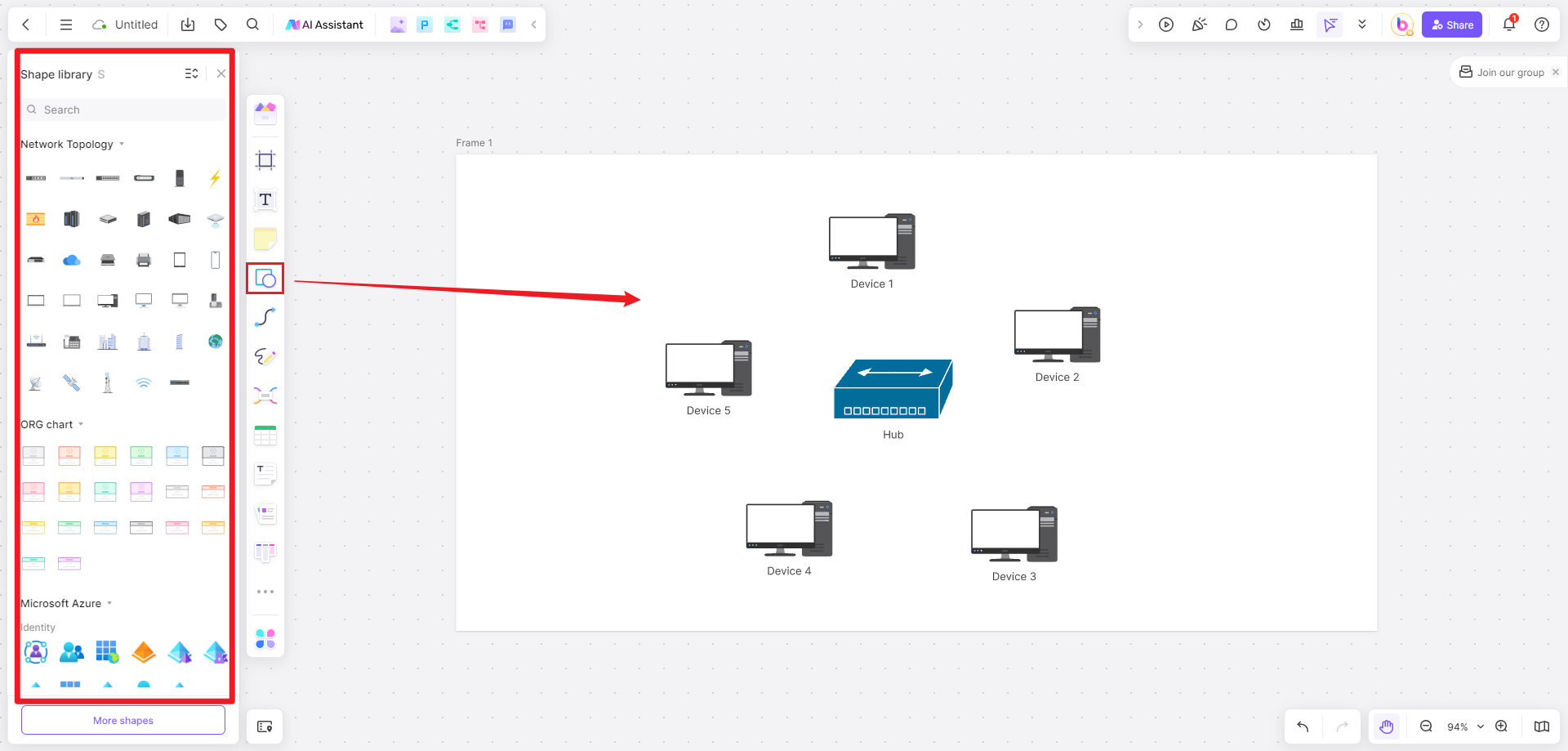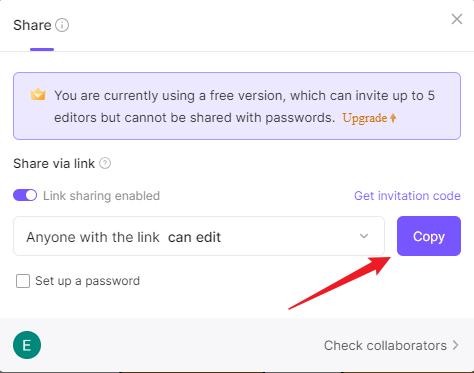Creating a Star Topology Diagram with an online maker can be likened to designing a constellation in the digital universe. It's about connecting each node, like a star, to a central hub, ensuring efficient data transmission and robust network performance. But this isn't just about linking stars to the hub. It's about utilizing the right online tool that allows you to create precise and visually appealing diagrams in just minutes. How does Boardmix simplify the process of creating a Star Topology Diagram? Let's learn and start the journey.
What is the Star Topology?
The star topology is a network configuration where all devices are connected to a central device, usually a switch or hub. In this configuration, each device is connected to the central device with a point-to-point connection, forming a star-like structure. The central device acts as a central control point and manages the communication between the connected devices. This topology is commonly used in Ethernet local area networks (LANs) and is known for its simplicity and scalability.

In a star topology, if one device fails or needs to be disconnected, it does not affect the rest of the network. Each device has its own dedicated connection to the central device, ensuring reliable and efficient communication. Additionally, adding or removing devices from the network is relatively easy in a star topology. Overall, the star network topology provides a high level of reliability, ease of installation, and flexibility for expanding or modifying the network. It is widely used in home networks, small businesses, and large organizations.

Star Network Topology Diagram Pros and Cons
The star network topology has several advantages and disadvantages.
Pros of Star Topology
- Centralized control: The central device in a star topology provides centralized control and management of the network. This makes it easier to troubleshoot and manage network issues.
- Reliable communication: Each device has its dedicated connection to the central device, ensuring reliable and efficient communication. If one device fails, it does not affect the rest of the network.
- Scalability: Adding or removing devices from the network is relatively easy in a star topology. You can simply connect or disconnect devices from the central device without disrupting the entire network.
- Easy to identify and isolate issues: Since each device is connected individually to the central device, it is easy to identify and isolate issues within the network. This makes troubleshooting faster and more efficient.
- Flexibility: The star topology allows for flexibility in network design. You can easily add or remove devices as needed without affecting the overall network performance.
Cons of Star Topology
- Single point of failure: The central device in a star network topology acts as a single point of failure. If the central device fails, the entire network will be affected.
- Cost: Implementing a star topology can be more expensive compared to other network topologies, as it requires additional hardware such as switches or hubs.
- Limited distance: The distance between the central device and connected devices is limited in a star topology. This may require additional hardware or devices to extend the reach of the network.
- Complexity in large networks: Managing large networks with multiple devices connected to the central device can be complex and time-consuming.
- Bandwidth limitations: The bandwidth in a star network topology is shared among all connected devices. If multiple devices are transmitting data simultaneously, it can lead to congestion and reduced network performance.
Overall, the star topology is widely used due to its reliability, scalability, and ease of installation. However, it is important to consider the specific needs and requirements of your network before choosing a topology.
Key Components and Connections of Star Topology Diagrams
When it comes to the key components and connections of a star topology, it's helpful to visualize it through diagrams.
3 Mian Components of Star Topology Diagram
In a star topology, there are three main components:
- Central device: This is the central point of control in the network, such as a switch or hub. All other devices are connected directly to this central device.
- Devices: These individual devices are connected to the central device. They can be computers, printers, servers, or any other network-enabled device.
- Connections: A dedicated point-to-point connection connects Each device to the central device. This can be an Ethernet cable, fiber optic cable, or any other type of network cable.
Connections of Star Topology Diagram
To better understand the connections in a star network topology, let's take a look at a diagram:

In this diagram, the switch represents the central device and Devices A and B are connected to the switch through dedicated connections. Each connection is independent and does not rely on the connections of other devices.
This is one of the main advantages of a star topology - if one device fails or needs to be disconnected, it does not affect the rest of the network. Each device has its dedicated connection to the central device, ensuring reliable and efficient communication.
It's important to note that in larger networks, multiple switches or hubs may be interconnected to create a more complex star topology. However, the basic principle remains the same - all devices are connected individually to a central device.
Why Use Online Diagram Maker for Creating Star Topology Diagram
When it comes to creating a star topology diagram, there are several reasons why use an online diagram maker.
Shift Towards Online Tools for Convenience
Online diagram makers provide convenience as they can be accessed from anywhere with an internet connection. This means that you can create and edit your star network topology diagram at your convenience, without the need for installing any software.
Benefits of Using Diagram-Making Platforms
Diagram-making platforms offer a range of benefits that make creating star topology diagrams easier and more efficient. Some of these benefits include:
- User-Friendly Interface: Online diagram makers often have intuitive interfaces that are easy to navigate, even for users with limited technical skills. This means that you don't need to be an expert in diagram creation to create a professional-looking star topology diagram.
- Collaboration and Sharing: Many online diagram makers allow for real-time collaboration, enabling multiple users to work on the same diagram simultaneously. This is especially useful for teams working on network designs or troubleshooting, as it allows for seamless collaboration and faster decision-making. Additionally, online diagram makers often provide options to share diagrams easily, either through a direct link or by exporting them in various file formats.
- Pre-Made Templates: Online diagram makers typically offer a wide range of pre-made templates, including templates specifically designed for star topology diagrams. These templates provide a starting point, saving you time and effort in creating the basic structure of your diagram. You can then customize the template to fit your specific network configuration.
Addressing Challenges in Traditional Diagram Creation
Traditional diagram creation methods, such as using drawing software or hand-drawing, can be time-consuming and prone to errors. Online diagram makers address these challenges by providing features like automatic alignment and snapping, which ensure that your diagram elements are properly aligned and connected. This not only saves time but also reduces the likelihood of mistakes in your diagram.
Boardmix online diagram maker for creating a star topology diagram offers convenience, a user-friendly interface, collaboration capabilities, and pre-made templates, and addresses challenges associated with traditional diagram creation methods. Whether you are a network professional or someone looking to visualize a network setup, using an online diagram maker can greatly simplify the process and enhance the quality of your star topology diagram.
Creating Star Topology Diagram in Boardmix: Step-by-Step Guide
Here are the steps to create a star topology diagram using Boardmix.
1. Sign in to Boardmix: Navigate to the Boardmix. If you already have a Boardmix account, sign in using your credentials. Otherwise, create a new account by providing the required information.

2. Choose a template or board: Once you're logged in, you'll be presented with a variety of diagram templates. Look for a template specifically designed for star network topology diagrams and select it. If you are not used to using templates, you can also choose to create a new board to suit your own style and new ideas.

3. Add shapes and connectors: Boardmix provides a wide range of shapes and connectors that you can use to create your diagram. Drag and drop the shapes onto the canvas and use the connectors to connect them. Place the central hub shape in the center of the canvas.

4. Customize the diagram: Customize the appearance of your diagram by changing the colors, fonts, and sizes of the shapes and connectors. You can also add labels and descriptions to each shape to provide more context.
5. Add additional elements: Depending on your needs, you may want to add additional elements to your diagram, such as devices or labels. Use the shape library in Boardmix to find the appropriate elements and add them to your diagram.

6. Arrange and align the elements: Organize the shapes in your diagram in a logical and visually appealing manner. Use Boardmix's alignment tools to ensure that the elements are properly aligned and evenly spaced.

7. Save and export: Once you're satisfied with your star topology diagram, save your progress. Boardmix allows you to save your diagrams directly to your account or export them in various file formats, such as PDF or image files.

8. Share and collaborate: If you're working with a team, you can easily share your diagram with others by providing them with a link or inviting them to collaborate directly within Boardmix. This allows for real-time collaboration and feedback.

That's it! Following these steps, you can create a star topology diagram using Boardmix. Enjoy creating your diagrams and exploring the features offered by Boardmix!
To Recap
In conclusion, crafting a Star Topology Diagram is simplified and expedited with Boardmix, the premier online collaborative teamwork tool. Understanding the intricacies of the Star Topology, with its centralized hub and connected nodes, is crucial for effective network planning. Boardmix seamlessly integrates the creation of Star Topology Diagrams into a streamlined and collaborative process.

Boardmix's user-friendly interface and collaborative features make it accessible to users of all technical levels. Its real-time collaboration capabilities allow teams to create, modify, and discuss diagrams efficiently, transforming the network planning process.
As organizations seek to optimize their network configurations, Boardmix invites users to take action and leverage its platform for creating Star Topology Diagrams effortlessly. Transform your network planning experience with Boardmix—where collaboration meets simplicity seamlessly. Create your Star Topology Diagrams online in minutes and propel your network efficiency to new heights.













